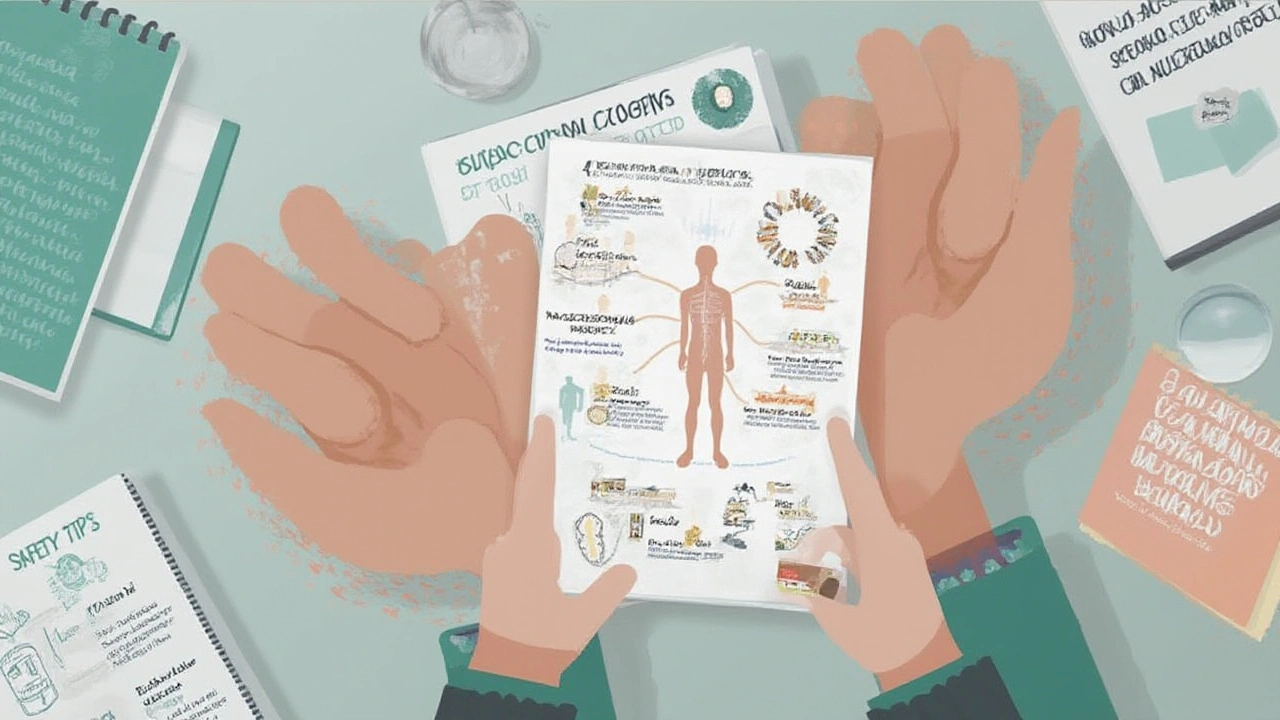Periactin Uses, Side Effects, and Tips You Must Know in 2025
 Jul, 1 2025
Jul, 1 2025
The moment someone mentions Periactin, you might picture a dusty old medicine for allergies your grandma kept in the cupboard, but this pill has an unexpectedly colorful life. It isn't just about the sniffles—Periactin’s rep goes from fighting off hives to helping kids and adults pack on pounds, and even dealing with migraine drama. You don’t quite expect one drug to bounce through so many uses, right? That’s what makes it weirdly fascinating.
What is Periactin and Why Do People Use It?
Periactin, known by its official generic name cyproheptadine, hit the U.S. pharmacy shelves back in the swinging 1960s. Sounds ancient, but it’s still prescribed today. It's an antihistamine, basically in the family of drugs that block histamine—a chemical your body pumps out when you hit something you're allergic to, whether it’s pollen, pet hair, or that one shrimp hiding in your favorite noodles.
Periactin doesn’t just calm sniffles and itchy skin. Doctors figured out, almost by accident, that it makes people pretty hungry. For kids who struggle to gain weight (because of something like cystic fibrosis, chronic illness, or picky eating with autism), this effect turned into a blessing. Adult cancer patients also use it to keep weight on during brutal treatments. According to a study published in The Journal of Pediatrics, “cyproheptadine has a significant impact on weight gain in undernourished children.” That’s the sort of happy accident you want in medicine sometimes.
Unlike newer allergy meds—think Zyrtec or Claritin—Periactin crosses the blood-brain barrier and makes people sleepy. That's a side effect most manufacturers try to avoid now, but for people who can't sleep anyway, or who are desperate to itch less at night, that drowsiness can be a hidden perk. And let’s not forget, migraines: Periactin is sometimes used in migraine prevention for kids, especially since so few options are kid-safe. The American Migraine Foundation notes, “cyproheptadine can reduce the frequency of migraines in pediatric cases.”
If you’re wondering how Periactin stacks up to modern drugs, look at popularity: allergies? Not so much anymore. Appetite? Big time, particularly outside the U.S.—some parts of Africa and Asia even sell it over the counter to parents who want chubbier kids, but that’s a whole ethical can of worms. In the U.S., you need a prescription.

How Does Periactin Work in the Body?
Cyproheptadine is a first-generation antihistamine, but unlike the fancy new allergy meds, it blocks not just histamine but also serotonin and acetylcholine in the brain. That’s why it punches through with more than just allergy relief—it flips switches on multiple body systems at once. Most allergy sufferers reach for *non-drowsy* meds today, but Periactin makes most users drowsy, especially in the first couple weeks.
The serotonin-blocking effect is why Periactin revs up appetite. Serotonin, in simple terms, is a feel-good brain chemical that monitors (and often suppresses) your urge to eat. So when Periactin blocks it, your appetite can go into overdrive. This is also why some people experience weight gain on prescriptions with accidental serotonin-blocking side effects—Periactin just leans into it on purpose.
Check out how the body reacts, side by side, in this table:
| Effect of Periactin | System or Symptom | Typical Outcome |
|---|---|---|
| Histamine Blockade | Allergy Symptoms | Reduced itching, hives, sneezing |
| Serotonin Blockade | Appetite | Increased hunger, weight gain |
| Acetylcholine Blockade | Nervous System | Drowsiness, dry mouth, sometimes blurry vision |
One thing to watch for: the more you take, the stronger these effects get. That sounds cool if you’re desperate to gain weight or need something to knock out a nasty itch, but overdoing it can have a downside. Dry mouth, constipation, blurry vision, confusion—especially in older adults—make a nasty cameo. So using it under a doctor’s watch is a must.
Let’s touch on the science a bit. Periactin isn’t considered safe for everyone. People with glaucoma, enlarged prostate, or peptic ulcers might see their symptoms get worse. Ever wonder why older adults are wary? The drug can lead to confusion, memory issues, and falls in seniors, so doctors often err on the side of caution.
For those using it for allergies, timing is everything. Take it before heading into allergy triggers, but know you might get sleepy. For folks using it as an appetite stimulant, the dose is gradually increased so side effects don’t hit you all at once. Some users swear by splitting the dose morning and night for fewer side effects and more steady results.

Tips, Dosages, and Real-World Stories About Periactin
Here’s where things get practical. First, dosage matters—a lot. For allergies and itching, adults usually start with 4 mg up to three times a day. For appetite stimulation, the typical start is 2 mg two to three times a day, but your doc will tweak this depending on how you react. Kids? Doses are much smaller, and always carefully monitored. Don’t try to adjust on your own—this isn’t something you want to play cowboy with.
One tip: watch out for drug interactions. Alcohol can crank up the drowsiness, so lay off the drinks. Don’t mix with other sedating medications unless your doctor gives the green light. If you’re already on antidepressants, especially SSRIs, let your provider know—mixing meds that mess with serotonin can get risky. The FDA has warned about serotonin syndrome, a rare but scary condition, when such drugs pile up together.
Parents often ask: “Will it really make my kid eat more?” The honest answer is, for some, yes—it works wonders. For others, the drowsiness is too much or it just doesn’t move the needle on hunger. Real-life stories line up both ways. One dad shared, “My son had stopped eating after his chemotherapy. Periactin was the only thing that brought his appetite back.”
But there are cautionary tales too. Some people pack on more pounds than planned, while others see changes in behavior—crankiness, hyperactivity, or grogginess that lasts all day. It’s a bit of a trial and error process, with close supervision. And always discuss any herbal supplements or vitamins you’re taking, because some can mess with how Periactin works.
Don’t skip taking it just because you feel better—if prescribed for long-term issues, sudden stops can make symptoms rebound. On the flip side, if you feel super groggy, spaced out, or notice a pounding heartbeat, call your doctor—those can be signs it’s not the best fit for you.
Insurance may or may not cover Periactin, depending on why it’s prescribed. If you’re using it for allergies, most plans will. If for appetite, you might need extra paperwork or an appeal. As of 2025, generic cyproheptadine is affordable at many U.S. pharmacies—think $15–$25 a month—but always shop around and ask about savings programs.
- Periactin may interact with antidepressants and alcohol
- Start at the lowest dose and increase only as needed
- If you notice dry mouth, suck on sugar-free candy
- Stay hydrated—constipation can sneak up
- Let someone know if you’re unusually sleepy or confused
For parents using Periactin for picky eaters, keep a food diary. Track what your child eats, any side effects seen, and mood changes. This log is gold for your next doctor visit, since tiny changes can make a big difference in side effects (and your peace of mind).
The use of Periactin does require open conversations. One quote from Dr. Lila Amir, a pediatric nutrition expert, says it best:
“Medications like Periactin are helpful tools, but they are no substitute for long-term strategies around nutrition and routine.”In short, think of Periactin as a short-term, strategic helper—not a forever fix.
If you’re hunting for information online, watch out: Not all advice is legit. Stick to sites tied to medical centers, major hospitals, or government sources. Avoid sketchy online sellers—counterfeit meds are a real problem, and you want what’s in the bottle to match the label, every time.
Long story short, Periactin stands out partly because it’s old-school, versatile, and honestly a little weird. Few meds from the 1960s are still helping both kids and adults today for such a wild range of reasons. Used thoughtfully, it can make a world of difference when nothing else does the trick. If you ever end up with that little white bottle in your hand, now you know the real story behind Periactin.

Jarod Wooden
July 10, 2025 AT 00:45Alright, let’s cut through the noise on Periactin. This isn’t just some run-of-the-mill antihistamine; its pharmacodynamics are actually quite compelling if you dive deep enough. Acting primarily as a potent H1 histamine receptor antagonist, it disrupts the usual histaminergic cascade, leading to relief from allergic manifestations and more intriguingly, off-label uses like appetite stimulation.
People pigeonhole Periactin as merely for allergies when in reality, it’s a biochemically versatile compound. But hey, the side effect profiles aren’t for the faint-hearted. Sedation, dizziness, and sometimes paradoxical excitation can make this a tricky beast to handle. You’ve gotta weigh these adverse effects against benefits critically, and always under strict medical supervision.
What’s imperative is understanding the pharmacokinetics and how variables like hepatic metabolism might alter its effective concentration. There’s a level of nuance in dosing schedules and how it interacts with cytochrome P450 enzymes that most casual users won't consider. Such factors profoundly influence safety and efficacy.
So if anyone's truly serious about grasping Periactin’s utility in 2025, I say don’t just skim the surface — go deeper and understand the intricacies that separate it from standard antihistamines.
Greg DiMedio
July 10, 2025 AT 01:51Oh great, another deep-dive into Periactin’s molecular mumbo jumbo. Honestly, who actually seeks this kind of elaborate explanation? Most people just want to know if it will knock out their allergies or make them eat more. Seriously, the vast majority don’t care about cytochrome P450 this or that.
And really, is sedation even a side effect needing an elaborate caution? Welcome to antihistamines, buddy. They make you drowsy. It’s like warning someone water is wet. Yeah, it works. Yeah, it makes you sleepy. Can we all move on now?
But thanks for trying to flex with your fancy pharma jargon — really adds that wow factor. Could’ve also mentioned it’s in that old medicine cabinet of every grandma over 60, just to keep it real.
lee charlie
July 10, 2025 AT 03:15This is really interesting—thanks for breaking down the complex stuff! It’s true, so many folks don’t realize that drugs like Periactin have layers beyond just allergy relief. But it makes me curious—do you think there are any lesser-known practical tips the average user might overlook?
I’m especially interested in real-life user experiences. Is there a consensus on how well people tolerate the drowsiness? Because sometimes those side effects can, well, really disrupt daily life. Also, are there natural ways to mitigate those side effects while still benefiting from the drug’s appetite stimulation?
It would be great to have some advice on managing those while still getting the good stuff. Any thoughts from others here on what worked for them?
Kasey Lauren
July 10, 2025 AT 04:05I want to add that from my experience, patience and timing your dose can help with some of the drowsy side effects. Taking it at night worked better for me than in the morning. Also drinking lots of water seemed to help with dizziness.
Just simple things really made a big difference for me. And I found talking to my doctor about any new symptoms helped me feel more confident about using Periactin safely. Everyone is different, though!
But overall, I've found it pretty helpful especially when I struggled with appetite due to other meds. That was a real game changer for me.
joshua Dangerfield
July 10, 2025 AT 04:38Hey, I’ve been following this thread and just wanna say that combining Periactin with other meds can sometimes be tricky. For example, since it’s metabolized in the liver, if you take it alongside things like some antidepressants or antifungals, it might increase or decrease its effectiveness unexpectedly.
Also, there are some reports online about people experiencing unusual mood swings or weird vivid dreams, which don’t always get discussed openly.
Had anyone else encountered anything like that? I think documenting these real-life stories is super important to give a full picture beyond clinical side effects listed.
Jarod Wooden
July 10, 2025 AT 05:28Yes, excellent point about polypharmacy interactions. The cytochrome P450 enzyme system is a notorious culprit in drug–drug interactions, and Periactin isn’t exempt. In fact, it’s metabolized primarily by CYP3A4. This means any strong inhibitors like ketoconazole or even grapefruit juice could significantly raise blood levels, increasing side effect risk.
Conversely, inducers like rifampin might reduce efficacy. So it’s not just about isolated use but the entire pharmacological milieu the patient is exposed to.
And as for those neuropsychiatric symptoms, the histaminergic antagonism in the central nervous system can explain some of those effects. It’s subtle but clinically relevant, especially in sensitive populations.
So those personal reports are gold for anyone seeking to truly understand this medication's variable impact.
Neil Collette
July 10, 2025 AT 06:01Sure, sure, pharmacokinetics 101. But let’s be honest here — how many people actually give a damn about grapefruit juice interactions? Most users wanna know if this stuff is gonna knock them out cold or just ramp up their appetite without turning them into zombies.
Plus, the neuropsychiatric side effects? Sounds like a fancy way of saying "sometimes you feel a bit off," which is textbook for half the drugs people take. Honestly, Periactin is just riding the antihistamine hype train with some extra perks.
Don’t get me wrong, it has its uses, but let’s not oversell it like it’s the second coming. Just be realistic about what this old-school drug can do in 2025.
Dennis Scholing
July 10, 2025 AT 06:35While the debates are lively, I’d urge everyone to remember that Periactin’s role has been validated through decades of clinical use and research. Its safety profile is well-documented when adherence to prescribed regimens is maintained. Therefore, it remains a useful therapeutic option especially in cases where stimulating appetite is a clinical priority.
It’s also important to encourage patients to consult healthcare professionals before making changes or starting therapy. Comprehensive education about potential side effects, drug interactions, and monitoring strategies can mitigate many risks and optimize therapeutic outcomes.
Health literacy and open dialogue between patients and providers form the cornerstone of safe Periactin use in 2025.
Badal Patel
July 10, 2025 AT 07:25Ah, the perennial tussle between scientific rigor and layman skepticism strikes again! Permit me to underscore the indispensability of rigorous pharmacological scrutiny when discussing Periactin. It is not merely a whimsical appetite stimulant or a benign antihistamine — it is a pharmaceutically intricate agent whose improper usage might precipitate a litany of untoward consequences.
Indeed, neglecting the metabolic pathways and potential for adverse reactions is analogous to sailing the seas blindfolded. I cannot overstate the imperative nature of pharmacy-led counsel, especially given the sophisticated drug–drug interactions that may arise.
One must approach Periactin with the judiciousness afforded to any potent medication, mindful that convenient anecdotes do not substitute comprehensive clinical understanding.
KIRAN nadarla
July 10, 2025 AT 08:15Typographical accuracy aside, I’ve observed that discussions around Periactin often gloss over the linguistic precision needed for conveying side effect data. It is 'dizziness,' not 'dizzyness'. Such slips may seem trivial but erode credibility.
From a grammatical and analytical standpoint, clarity in describing adverse effects and dosing instructions is paramount for patient safety. I recommend authors and posters apply meticulous proofreading to avoid ambiguity.
Furthermore, it is prudent to delineate between common and rare side effects with appropriate qualifiers to prevent misinformation. Ambiguity in these details can inadvertently mislead users about risk profiles.